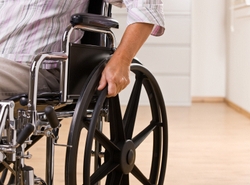
A new Northwestern Medicine® brain-machine technology delivers messages from the brain directly to the muscles – bypassing the spinal cord – to enable voluntary and complex movement of a paralyzed hand. The device could eventually be tested on, and perhaps aid, paralyzed patients.
“We are eavesdropping on the natural electrical signals from the brain that tell the arm and hand how to move, and sending those signals directly to the muscles,” said Lee E. Miller, PhD, Edgar C. Stuntz Distinguished Professor in Neuroscience and the lead investigator of the study, which was published in Nature. “This connection from brain to muscles might someday be used to help patients paralyzed due to spinal cord injury perform activities of daily living and achieve greater independence.”
The research was done in monkeys, whose electrical brain and muscle signals were recorded by implanted electrodes when they grasped a ball, lifted it and released it into a small tube. Those recordings allowed the researchers to develop an algorithm or “decoder” that enabled them to process the brain signals and predict the patterns of muscle activity when the monkeys wanted to move the ball.
These experiments were performed by Christian Ethier, a post-doctoral fellow, and Emily Oby, a graduate student in neuroscience. The researchers gave the monkeys a local anesthetic to block nerve activity at the elbow, causing temporary, painless paralysis of the hand. With the help of the special devices in the brain and the arm – together called a neuroprosthesis – the monkeys’ brain signals were used to control tiny electric currents delivered in less than 40 milliseconds to their muscles, causing them to contract, and allowing the monkeys to pick up the ball and complete the task nearly as well as they did before.
“The monkey won’t use his hand perfectly, but there is a process of motor learning that we think is very similar to the process you go through when you learn to use a new computer mouse or a different tennis racquet. Things are different and you learn to adjust to them,” said Miller, also a professor of physiology and of physical medicine and rehabilitation.
Because the researchers computed the relationship between brain activity and muscle activity, the neuroprosthesis actually senses and interprets a variety of movements a monkey may want to make, theoretically enabling it to make a range of voluntary hand movements.
“This gives the monkey voluntary control of his hand that is not possible with the current clinical prostheses,” Miller said.
The Freehand prosthesis is one of several prostheses available to patients paralyzed by spinal cord injuries that are intended to restore the ability to grasp. Provided these patients can still move their shoulders, an upward shrug stimulates the electrodes to make the hand close. A shrug down stimulates the muscles to make the hand open. The patient also is able to select whether the prosthesis provides a power grasp in which all the fingers are curled around an object like a drinking glass, or a key grasp in which a thin object like a key is grasped between the thumb and curled index finger.
In the new system that Miller and his team have designed, a tiny implant called a multi-electrode array detects the activity of about 100 neurons in the brain and serves as the interface between the brain and a computer that deciphers the signals that generate hand movements.
“We can extract a remarkable amount of information from only 100 neurons, even though there are literally a million neurons involved in making that movement,” Miller said. “One reason is that these are output neurons that normally send signals to the muscles. Behind these neurons are many others that are making the calculations the brain needs in order to control movement. We are looking at the end result from all those calculations.”






